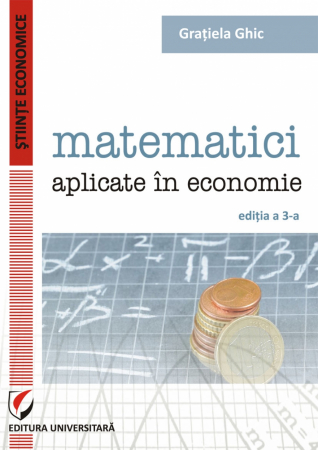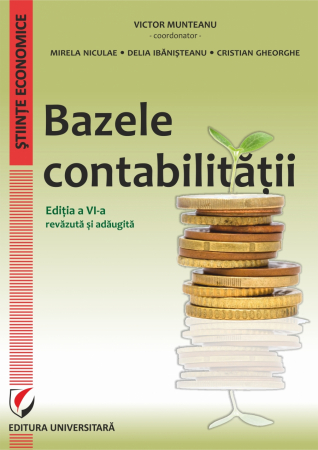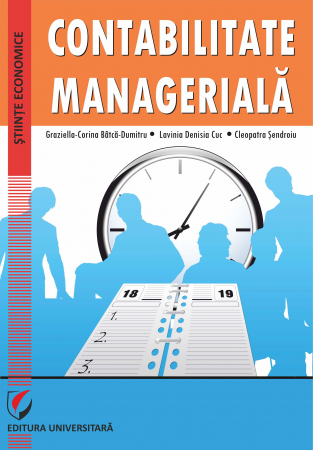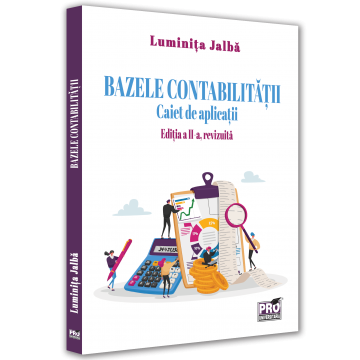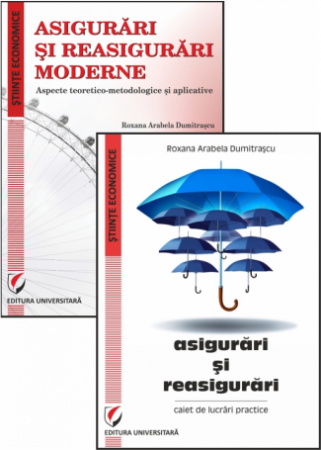ISBN: 978-606-28-0079-6
DOI: 10.5682/9786062800796
Publisher year: 2014
Edition: II, revizuita
Pages: 214
Publisher: Editura Universitară
Author: Doina Maria Tilea, Dragos Laurentiu Zaharia, Victor Munteanu, Vasile Bleotu
- Description
- Download (1)
- Authors
- Content
- More details
- Reviews (0)
The present paper addresses those students eager to decipher the fundamentals of accounting, to advance novelty elements in terms of approaching accounting in the spectrum of financing public institutions, having as a tool and limits at the same time, the public budget of revenues and expenditures.
Thus, a series of proposals are advanced regarding the efficient approach of public expenditures, methods of attracting public revenues and their optimal allocation in order to rationally satisfy the main nomenclatures of expenditures, being known the need to harmonize the process of allocating resources with general interest, that of achieving a balance between the main societal forces.
This paper presents a complex approach, in 10 chapters, of the discipline "Accounting of public institutions", aims at an optimal allocation of revenues following the improvement of their collection rate.
We consider that this work is the result of a rich experience in the field of authors, offering an extra chance to improve the daily activity of those present in the world of accounting, increasing their efficiency.
Perhaps the most important approach of the authors is to make a critical analysis of the current accounting system in public institutions. In this context, we propose a series of novelty elements regarding the accounting methods and practices regarding the balance sheet structures.
In view of these values of the book, we consider that specialists and especially students, will be determined in the study of this paper, being entitled to ask the authors for clarifications, customizations and explanations.
-
Contabilitatea si raportarea financiara la institutiile publice
Download
DOINA MARIA TILEA
VASILE BLEOTU
DRAGOS LAURENTIU ZAHARIA
PREFACE / 8
CHAPTER I: THE SECTOR OF PUBLIC INSTITUTIONS - ITS PLACE, ROLE AND IMPORTANCE AT INTERNATIONAL PLAN AND IN ROMANIA / 9
1.1. Definition and legal framework regarding public institutions / 9
1.2. Classification and scope of public institutions / 9
1.3. Budget - evaluative and comparative table of public revenues and expenditures / 11
1.3.1. Budgetary principles and rules / 12
1.3.2. Components of the public budget / 13
1.3.3. Budgetary financing of public expenditures / 15
1.3.4. Organizing the budget system in Romania / 23
1.3.5. Stages of the budgetary process / 24
1.4. The life of public institutions: constitution, functioning, dissolution, liquidation / 26
1.5. The evolution of the public institutions sector at international level and in Romania / 27
1.6. The current and perspective situation of the public institutions sector in Romania and in the world / 28
CHAPTER II: GENERAL ASPECTS AND PARTICULARS REGARDING PUBLIC INSTITUTIONS / 29
2.1. Historical aspects regarding the accounting of public institutions / 29
2.2. Peculiarities of the accounting of public institutions / 35
2.2.1. Documents specific to public institutions and accounting registers / 36
2.2.2. Principles of public accounting / 39
2.2.3. Financial statements (reports) prepared by public institutions / 39
2.2.4. Chart of accounts of public institutions / 45
CHAPTER III: CONVERGENTS AND HARMONIZATIONS IN THE ACCOUNTING OF PUBLIC INSTITUTIONS / 46
3.1. The role and specificity of the accounting reform in the sector of public institutions / 46
3.1.1. The stages of the accounting reform in the sector of public institutions in Romania / 47
3.1.2. The old accounting system versus the new accounting system of public institutions / 48
3.2. Harmonization and normalization in the accounting of public institutions / 49
3.2.1. Defining the concepts of harmonization and normalization in accounting / 49
3.2.2. The evolution of the process of harmonization and normalization in international accounting in Romania / 50
3.2.3. The specifics of the process of harmonization and normalization in the accounting of public institutions / 50
CHAPTER IV: CAPITAL ACCOUNTING / 51
4.1. The role and importance of capital / 51
4.2. Revaluation reserve accounting / 54
4.3. Provision-specific accounting / 55
4.4. Accounting specific to non - current debts / 56
4.4.1. Accounting for loans from the bond issue / 56
4.4.2. Accounting specific to leasing transactions / 58
4.5. Capital accounting practices / 59
CHAPTER V: ACCOUNTING OF FIXED ASSETS / 69
5.1. The role and importance of fixed assets / 69
5.2. Accounting policies specific to fixed assets / 72
5.2.1. Valuation of fixed assets / 72
5.2.2. Accounting for transactions and events related to tangible fixed assets / 76
5.2.3. Accounting for financial fixed assets / 78
5.3. Accounting practices regarding fixed assets / 79
CHAPTER VI: STOCK ACCOUNTING / 88
6.1. The role and importance of stocks / 88
6.2. Inventory accounting policies / 90
6.2.1. Stock valuation / 90
6.2.2. Information stocks on stocks / 92
6.3. Ways of exploiting stocks in public institutions / 94
6.4. Inventory accounting practices / 98
CHAPTER VII: ACCOUNTING OF RECEIVABLES AND LIABILITIES / 107
7.1. The importance of current receivables and debts / 107
7.2. Accounting policies regarding receivables and debts / 108
7.2.1. Valuation of receivables and debts / 108
7.2.2. Settlement accounting with suppliers and customers / 109
7.2.3. Accounting for settlements with the state budget / 109
7.3. Accounting practices regarding current receivables and debts / 111
CHAPTER VIII: TREASURY ACCOUNTING / 117
8.1. The role and importance of the treasury / 117
8.2. Treasury accounting policies / 120
8.3. Short - term investment accounting / 120
8.4. House, accounts with the state treasury and banks / 121
8.5. Treasury accounting practices / 123
CHAPTER IX: EXPENDITURE AND REVENUE ACCOUNTING / 130
9.1. Concepts and typologies regarding expenses and incomes / 130
9.2. Accounting practices regarding expenses and revenues / 131
CHAPTER X: IMPROVING THE ACCOUNTING OF PUBLIC INSTITUTIONS IN ACCORDANCE WITH INTERNATIONAL PUBLIC SECTOR ACCOUNTING STANDARDS / 134
10.1. Critical analysis of the current accounting system in public institutions / 134
10.2. International Accounting Standards for the Public Sector / 136
10.2.1. Compliance with international accounting standards / 138
10.2.2. Cash accounting or accrual accounting / 142
10.3. European Commission Regulations on "Presentation of Accounts and Accounting" / 145
10.3.1. Convergence of the reporting system of public institutions with the International Accounting Standards for the Public Sector regarding the presentation of the financial statements (IPSAS 1 and IPSAS 2) / 146
10.3.2. Convergence of national norms with International Accounting Standards for the Public Sector regarding balance sheet items (assets and liabilities) / 166
10.3.3. Convergence of national norms with the International Accounting Standards for the Public Sector regarding the elements from the Equity Income Account (income and expenses) / 178
BIBLIOGRAPHY / 206
One of the most sought after disciplines among economists is accounting. This discipline, most of the time dull, is enlivened due to the zeal and discretion of the teachers to render, both synthetically and analytically, the coordinates of accounting.
The present paper addresses those students eager to decipher the fundamentals of accounting, to advance novelty elements in terms of approaching accounting in the spectrum of financing public institutions, having as a tool and limits at the same time, the public budget of revenues and expenditures.
Thus, a series of proposals are advanced regarding the efficient approach of public expenditures, methods of attracting public revenues and their optimal allocation in order to rationally satisfy the main nomenclatures of expenditures, being known the need to harmonize the process of allocating resources with general interest, that of achieving a balance between the main societal forces.
This paper presents a complex approach, in 10 chapters, of the discipline "Accounting of public institutions", aims at an optimal allocation of revenues following the improvement of their collection rate.
We consider that this work is the result of a rich experience in the field of authors, offering an extra chance to improve the daily activity of those present in the world of accounting, increasing their efficiency.
Perhaps the most important approach of the authors is to make a critical analysis of the current accounting system in public institutions. In this context, we propose a series of novelty elements regarding the accounting methods and practices regarding the balance sheet structures.
In view of these values of the book, we consider that specialists and especially students, will be determined in the study of this paper, being entitled to ask the authors for clarifications, customizations and explanations.

6359.png)
![Accounting and financial reporting of public institutions [1] Accounting and financial reporting of public institutions [1]](https://gomagcdn.ro/domains/editurauniversitara.ro/files/product/large/contabilitatea-si-raportarea-financiara-la-institutiile-publice-924-730219.jpg)


